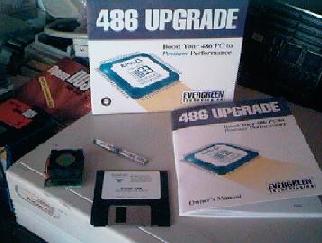

 |
 |


My wife hates what I've done to the spare room. It has nothing to do with colour coordination or disagreements over wallpaper design. It has everything to do with the fact that almost every square inch of available floor space is given over to the storage of outdated and mostly unused computer equipment. I have everything from an Apple LaserWriter-I to CP/M laptops to a complete 486 tower system stacked in there. Does this sound familiar to anyone?
While that particular 486 tower is too noisy for home use, another 486 system, a desktop Compaq Prolinea 4/33, is one of my favourite workhorses. Originally consigned to the corporate junk heap, I rescued it, swapped the old 127MB disk for a more modern 2.1GB model, installed Linux and then configured it to be the main NFS/Samba server on my home network. In addition to that task, I use it as an xhost server for a Sun IPC (the IPC has a much nicer keyboard and a higher definition display than the Compaq), as a PLIP server for a 386 laptop and also as a compile engine for all of the other 386 class machines in my motley stable. However, while the hour or so required for a kernel compile is much better than the overnight wait required for an i386 machine to complete the same task, it is still fairly tedious, especially when working on experimental changes, so for some time now I've been on the lookout for a viable upgrade.
Unfortunately, bringing yet another system into the house doesn't pass the good housekeeping test. (Besides which, I don't have the cash available for a new system and Pentium Pro machines haven't yet started to appear on the company junk heap.) While a motherboard upgrade looked promising initially, the unique internal layout of the Prolinea, specifically the orientation of the ISA expansion slots, would have meant having to buy a chassis as well as the motherboard. Add the cost of that to my wife's understandable reluctance to allow anything resembling yet another computer into the house, and the obvious answer was to opt for an upgrade processor instead.
A quick check of the local shops here in rural Japan proved disappointing, with a dearth of 486 upgrade options. A couple of shops did carry the standard Intel Over-Drive kit, but at a truly extortionist price. As it happened though, I had recently received a catalogue from a U.S. mail-order house and a check showed 486 to 586/133MHz upgrades at a very attractive price--only $109.95 for a kit, with the added promise of a much greater performance increase than the Intel version. Was it too good to be true? Well, there was only one way to find out, and at that price I wasn't going to be too much out of pocket even if it turned out to be a complete lemon.
The Evergreen 486 upgrade kit comes in a fairly bulky box, with most of the volume being taken up by pre-formed packing designed to prevent damage to the pins on the upgrade processor. The kit contains the processor assembly, a chip removal tool, a diskette containing a diagnostic program, an instruction manual and a $10 refund voucher (which, in my case, had expired one week before I actually received the kit).
The processor assembly consists of a plastic, flat-pack chip mounted on a small PCB with three configuration jumpers to one side. The chip has a heat-sink and fan assembly already attached. There are no external power connections for the fan (operating power being drawn through the socket). The CPU is a 133MHz 5x86 processor from AMD with 16KB of internal cache. The clock speed multiplier is jumper selectable, making the processor a drop-in replacement for 25, 33, 40, 50, 66 or 80MHz 486SX or 486DX chips. The other two jumpers are used to select over-drive or main processor socket placement and the cache mode.
The instruction manual is straightforward, with clear illustrations of the various socket configurations which a typical user might encounter. The jumper settings are well explained, with the notable exception of the cache configuration jumper (more on this later). It also contains lots of sound, common-sense advice, such as marking the orientation of pin-1 of your original processor on the mother board before removing it from the socket. (Many motherboards have the silk-screen markings obscured by other components.) In addition, some 22 of a total of 72 pages are dedicated to a fairly comprehensive troubleshooting guide. On the down side (and pretty much as you'd expect), it doesn't contain any mention of operating systems other than DOS or Windows.
This extends to the diagnostic diskette, too. The diagnostic program, etdiag, will run only under DOS and, because it is designed to measure system performance, it cannot be run under DOSEMU in Linux. This can be something of a problem in a Microsoft-free zone, but I did discover that etdiag would run under at least two versions of DOS which are readily available from the Internet: one a completely free version and the other a cut-down, evaluation version of a commercial product--refer to the resources sidebar for URLs. One of the neat things about etdiag is that it will recommend a specific upgrade processor model, based on what it discovers about your system during the initial test, and because Evergreen makes the diagnostic available from their web site, you can use this facility before buying an upgrade kit.
The actual chip replacement process shouldn't cause anyone too much trouble. The chip removal tool supplied with the kit is somewhat thicker than ones I've encountered previously, but with a little bit of patience and minimal effort I was able to ease my original processor out of its socket and replace it with the Evergreen unit. I checked to make sure the fan was turning and the system had completed its power-on self test successfully before replacing the system top cover.
Booting the diagnostic again confirmed the new chip type, higher internal clock speed and increased cache memory were identified correctly. The Dhrystone rating for the CPU (measured under etdiag) had also jumped from the original value of 15384 to a very respectable 39370, increase in performance of two and a half times. Booting Linux showed a BogoMIPs rating increase of exactly four, from 16.59 with the original 33MHz 486 chip, to 66.36 for the 133MHz 586 chip, which is pretty much what you'd expect with a quadrupled clock.
While overall performance is very subjective (few of us use exactly the same mix of tools and applications), I have to say that, for me, the upgrade was a huge improvement. The machine felt completely different with applications starting and running faster and boot-up and shut-down times greatly reduced.
A kernel compile ran almost exactly twice as fast, with the upgraded machine completing a make clean; make zImage in 31:36.66 seconds, a task which the original 486 processor completed in an elapsed time (measured using /usr/bin/time) of 1:00:30.24 (slightly over one hour). Given that the rest of the system (main memory and the I/O subsystem) was unchanged, this is quite a respectable increase in performance. Perhaps the biggest perceived change was to the performance of xhosted applications. Netscape, always a CPU and memory hog, started up much faster, as did xterms, a clock and the other applications which I normally run. X performance on the system also improved, but with the current, low resolution monitor and standard VGA video card, I don't envisage using it as a true desktop machine very much (perhaps that's the next upgrade target area). Network (NFS/Samba) performance seemed pretty much unchanged.
There isn't one. Nothing needs to be recompiled or changed in any way. There are no reliability issues. The fan on the Evergreen unit is completely inaudible when the covers are on the system.
The only fault I have with the whole kit is that mysterious cache configuration jumper. It is clearly shown in the illustrations, but ignored in the body of the text. The appendix contains a brief explanation of the differences between write-through and write-back cache. The kit comes with the jumper pre-set to a default of write-through and while it is unlikely anyone could get into trouble using this setting, a simple comment, even if only ``leave well alone'', would have been better than nothing at all.
This lack of information on the cache configuration setting led to my trying out Evergreen's technical support by e-mail. They responded to my question within 48 hours, to let me know that the write-back cache option will work only with systems which have been specifically designed with that option in mind. The fact that Evergreen's tech-support responded within a reasonable time and that their web site is an easily accessible, round-the-clock source of information is of no little importance with a product where some degree of ``do it yourself'' is involved.
For anyone owning nothing more powerful than a 486 and on a limited budget, this upgrade path is certainly one which I would recommend. Overall system performance has been improved with no decrease in reliability. There were no operating system changes involved and my existing kernel worked fine.
With all of this coming at a cost roughly equivalent to one-tenth of the cheapest, bottom-end system from a mainstream manufacturer, it has to qualify as perhaps the cheapest, legal way to get yourself a ``new'' machine. Not only that, but your ``significant other'' need never know.

John Little, who worked for Sun for nine years, is from the U.K., lives in Japan and works in Tokyo for an American company. He wears a range of increasingly bizarre hats in an (mostly futile) effort to hide his incipient baldness. He can be reached by e-mail at gaijin@pobox.com.